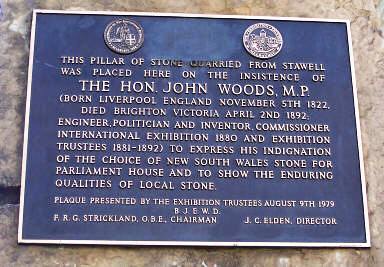A Monument to Sydney-Melbourne Rivalry
This article was first published in the White
Hat Melbourne Newsletter No.204 on 1 February 2007
 “You
think someone would remove it or tidy it up.” The visitors were
obviously from that area of Europe where tidiness is written into the
constitution. And I had to admit that the large lump of stone on a rudely
constructed base was less than impressive.
“You
think someone would remove it or tidy it up.” The visitors were
obviously from that area of Europe where tidiness is written into the
constitution. And I had to admit that the large lump of stone on a rudely
constructed base was less than impressive.
Our visitors were not to know that it was really a monument to
Sydney-Melbourne rivalry. Maybe a little background to the origins of this
strange preoccupation well known to most Australians. Melbourne was a late
starter. By the time the rival parties of Batman and Fawkner arrived in the
area in 1835 to form the little European settlement, Sydney had been
established for nearly fifty years. The authorities arrived from Sydney to
inspect. There had been several attempts at government-sanctioned
settlements in the Port Phillip area but none were sustainable. However the
authorities from Sydney had to reluctantly admit that, unlike their own
attempts, this settlement initiated by private enterprise seemed viable.
Score one to Melbourne.
However it would have to have laws and taxes and be governed from Sydney.
Score ten to Sydney.
Governor Bourke from Sydney arrived and had his military surveyor Robert
Hoddle lay out a street grid for Melbourne. Governor Bourke then named the
streets making sure that he got top billing. Thus Bourke Street in Melbourne
is named after the governor from Sydney.
For fifteen years all major decisions about Melbourne were made in Sydney
by people who for the most had never seen the place and often expressed
distaste at the prospect of one day doing so. One of the first public
buildings they decided Melbourne should have was a gaol. A large gaol. Up on
the hill where it would dominate the skyline of the town. “Can you
imagine!” said the people of Melbourne. “Just because their town is a
penal settlement crawling with convicts they think our town, founded by an
Australian-born free settler, needs a large gaol. We all came to this part
of the world of our own accord and if some don’t want to talk much about
their background that’s their prerogative.” The foundations of the
Melbourne-Sydney resentment were becoming well and truly established.
During this period, two major social issues that attracted heated comment
were ‘anti-transportation’ and ‘separation’. Anti-transportation referred to
opposing the use of the Port Phillip area as a penal settlement where
convicts from England could be transported. That would keep the settlement
on a higher moral plane than those up north. The issue of separation
referred to separation from New South Wales and becoming an independent
colony. In another settlement one would expect a label such as ‘colonial
status’ to be used for such an aspiration. But in Melbourne the key word was
separation - separation from Sydney!
In 1851, word arrived from Queen Victoria that Melbourne was to become
part of a separate colony (named after herself of course) and there were
unprecedented celebrations. Bonfires were lit across the state, one week’s
public holiday was declared and a grand separation procession was held
through the streets of Melbourne. Scarcely had the last bonfire embers
ceased to glow when it was announced that gold had been discovered in
country Victoria. With gold money pouring in, Melbourne set about building
itself a Parliament House. But no ordinary Parliament House. This was to be
much bigger and much more impressive than Sydney’s. We were very proud of
our Parliament House but there was one minor point which people knew you did
not mention in polite society. It remained unmentioned until an engineer
(who on the whole are not renowned for their mastery of social niceties)
erected this monument.
The inscription reads: This pillar of stone quarried from Stawell was
placed here on the INSISTENCE of the Hon. John Woods, M.P. (born
Liverpool England November 5th 1822, died Brighton Victoria April 2nd 1892;
engineer, politician and inventor, Commissioner International Exhibition
1880 and Exhibition Trustees 1881�1892) to express his INDIGNATION of
the choice of New South Wales stone for Parliament House and to show the
enduring qualities of local stone.
I think of suggesting to our visitors that if they read the inscription
they might understand why that lump of stone is there. On second thoughts I
suspect that would only make them more confused.

|
|
Copyright © 1995 - 2025
White Hat.
|
Other articles in the series Seven Monuments of Melbourne: